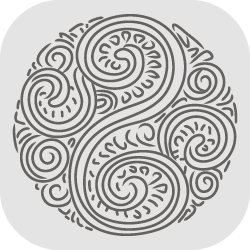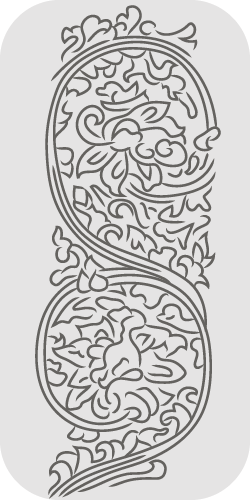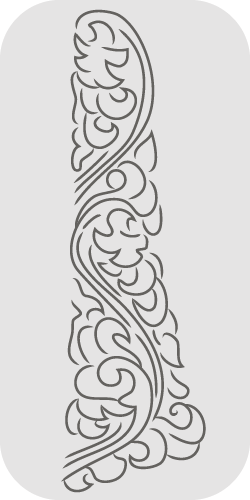- Object Date
- Goryeo 고려 高麗 dynasty (918–1392), mid-fourteenth century
- Medium
- Hanging scroll; ink, color, and gold on silk
- Dimensions
- Image: 159.6 x 82.5 cm (62 13/16 x 32 1/2 in.)
Overall: 274.3 x 114.3 cm (108 x 45 in.)
- Credit Line
- Bequest of Grenville Lindall Winthrop
- Collection
- Arthur M. Sackler Museum, Harvard University Art Museums
- Accession Number
- 1943.57.12
- Provenance
To 1937
Baron Go Seinosuke 郷誠之助 (1865–1942), Tokyo, JapanFrom 1937 to 1943
Grenville Lindall Winthrop (1864–1943), New York, NYFrom 1943
Harvard University Art Museums
- Apparatus
- The nineteenth-century Meiji 明治 Japanese lacquer storage box that accompanies this scroll includes an inscription that attributes the scroll to the eighth-century Chinese artist Wu Daozi 吳道子 (act. ca. 710–760).
- Remarks
(Prof. Gim Jeunghui [Kim Jung Hee] 김정희, specialist in Korean Buddhist painting and professor of art history at Iksan [Wongang] University 원광대학교, July 27, 2009) The linked-S decoration that borders the bodhisattva’s robe is very unusual; hadn’t previously seen this particular pattern. This painting is very unusual in being so well-preserved—so well-preserved, in fact, that the rocks and bamboo are visible along the painting’s right edge. By contrast, most Goryeo 고려 高麗 Buddhist paintings are so damaged that the paradise landscape in which the bodhisattva is seated is no longer visible. This painting might date to the early Joseon조선 朝鮮 period (rather than to late Goryeo 고려 高麗). It is not so delicately painted as many other Goryeo 고려 高麗 bodhisattva scrolls, but it makes up for the lack of delicacy in being much better preserved than other related scrolls.
- Published References
Hanguk Gukje Gyoryu Jaedan 한국국제교류재단. Miguk bangmulgwan sojang Hanguk munhwajae 미국박물관 소장 한국문화재 [Korean Relics in the United States]. Seoul: Hanguk Gukje Munhwa Hyeopoe, 1989. 164, no. 14.
Mowry, Robert D. “Seated Willow-Branch Kwan’um Posal [Bodhisattva Avalokitesvara].” Harvard’s Art Museums: 100 Years of Collecting. Cambridge, MA: Harvard University Art Museums, 1996. 70–71.
Kikutake Junichi 菊竹淳一 and Chung Woothak 鄭于澤, eds. Goryeo sidae ui bulhwa 高麗時代의 佛畵 [The Buddhist paintings of Koryo dynasty]. Seoul: Sigongsa, 1997. Vol. 1: 186, pl. 86; Vol. 2: 95.
Kikutake Junichi 菊竹淳一 and Chung Woothak 鄭于澤, eds. Kōrai jidai no butsuga 高麗時代の仏画
[The Buddhist paintings of Koryo Dynasty]. Seoul: Sigongsa, 2000. 186, 453, pl. 86.Stokstad, Marylyn and Robert D. Mowry et al. Art History, 3rd revised edition. New York: Princeton Hall, 2007. 370, fig. 10–30.
Wolohojian, Stephan. Harvard Art Museum: Handbook. Cambridge, MA: Harvard University Press, 2008. 49.
Chung Woothak 정우택. “Miguk sojae Hanguk bulhwa josa yeongu 미국소재 한국불화 조사 연구 [Investigation Research on the Korean Buddhist Painting in the United States].” Dongak misulsahak 東岳美術史學 13 (2012): 41–42, fig. 8.
Neave, Dorinda, Lara C. W. Blanchard, Marika Sardar, and Miranda Bruce-Mitford. Asian Art. Boston: Pearson, 2015. 252, ills. 11–12.
Kang Soyon. "The Moon Reflected in the Water: The Miraculous Response of Avalokitesvara in 'Water-moon Avalokitesvara Paintings’ of the Goryeo Dynasty." The Eastern Buddhist 47, no. 1 (2016): frontispiece, 32–34, figs. 1a-d.
- Restrictions & Rights
- Copyright with museum



















